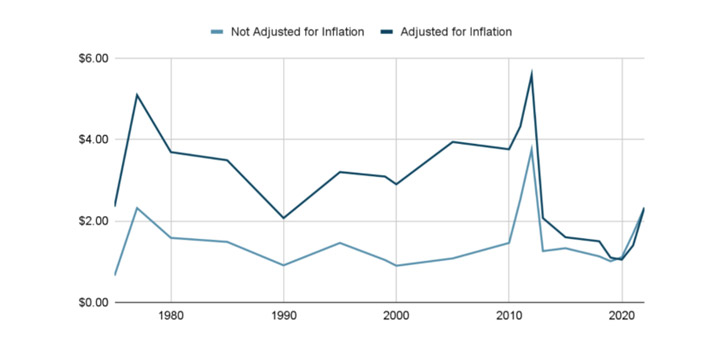
Some say coffee has become a necessity––or an addiction! Regardless, it’s a vital morning staple, but it doesn’t magically appear on our breakfast table. Coffee is a simple pleasure for the consumer, but it can be far from simple for the coffee farmers and the exporters.
The coffee plant goes through a fantastic trading process, filled with financial and geographical mystique. Between prices, inflation, exports, and imports, things can get confusing fast, but it doesn’t have to boggle the mind!
Oftentimes, the C Market is known as the foundation of our international coffee market, so it’s a fantastic place to start.
So, What Is the C Market?
Everything a consumer buys is traded similarly to stocks and bonds in today's world. The “C” in C Market doesn’t stand for “commodity” like one would think––it appropriately stands for “centrals.” But that doesn’t mean coffee’s not a commodity–– it is!
Commodities are raw materials like wheat, cotton, oil, sugar, silver, and coffee. The “centrals” represent the centralization, or unification, of the world’s coffee sources under one contract. Still, it can also refer to Central America––the area responsible for the C Market’s birth in 1968. In fact, before the C Market, Arabica coffee wasn't differentiated from other origins in its market (like Brazil in South America), which made things even more complicated for traders and coffee-producing countries. Thus, for example, Arabica and Robusta coffees have their own markets for ease.
The C Market represents the worldwide exchange, in which the total supply of Arabica coffee is traded––bought and sold––daily. It’s added to the total price (including packaging, labor, beans, etc.), but before the coffee can even be considered for the C Market, it must pass extensive quality tests:
- The coffee must be Arabica.
- It must come in raw (unroasted) form.
- It must originate from an approved country and an approved warehouse.
- Its shipping container must hold quantities of nearly 38,000 pounds.
But Why Do We Need Such a Convoluted System for Something Like Coffee? And How Are They Similar to Stocks and Bonds?
As for commodity markets, they’ve lasted thousands of years. Some of the world’s first, economically successful civilizations created them by combining the spot market and the futures market.
The spot market represents a physical sale as it’s happening in real-time––think of a traditional farmer’s market. This worked, of course, but there were some key issues, especially for a crop commodity like coffee. For example, what about the coffee flow? Was there a frost that destroyed some crops? Was there a labor shortage? The spot market leaves out a lot of factors, which brought forth the futures market.
The futures market simplified the process. It took months for farmers to even produce coffee before they could sell it, and there were factors (climate, labor, etc.) that could inevitably affect the price. Farmers would raise prices without giving consumers a heads-up! To avoid uncertainty and mistrust, the futures market initiated contracts that would allow consumers to agree on possible prices.
Sadly, another considerable problem arose––sometimes, one of the parties (farmer or consumer) would back out of their contract without warning. The farmer would be at the spot market’s mercy and ultimately lose money, which could cause bankruptcy.
Something had to be done––a system had to be created in which there were few foreseeable conflicts. The futures market was almost perfect––it just needed a few more tweaks––and after those adjustments were made, the C Market we know today was born.
How Does Today’s C Market Work?
ICE (International Exchange) runs today’s futures C Market, and it acts as a mediation between the buyers and sellers. Companies sell their coffee to the exchange, so the C Market cannot go out of business. Any liquidity issues are nipped in the bud because sellers always have a buyer on the other end of the line and vice versa. Because of the C Market’s rules and regulations today, the coffee flow is stable, and prices are set as a benchmark.
How Does This Affect the Price of My Coffee?
Although the C Market’s prices are not the total value of your cup of coffee (it’s added to packaging, labor, etc.), it’s affected by the same factors as the crop itself––weather, shipping constraints, labor and packaging shortages, panic buying, global events, etc. Because of these reasons, it's subject to inflation. All in all, the coffee price is only a fraction of a brand’s expenses.
Due to the frightening weather in Brazil and the pandemic, we are seeing the first major C Market inflation in more than ten years––in 2011 there was a demand explosion and a “coffee at-home” trend wave with almost half of coffee drinkers investing in roasters and machines for their kitchen.
When looking at the big picture, you can see that coffee bean prices fluctuate in almost what could be described as a zig-zag. However, when you adjust for today’s inflation, coffee prices have overall decreased. Within this decade, prices have gone up, but compared to the late 70s, it’s actually lower when you calculate inflation’s effects. Below, you can see an estimated visual on coffee prices throughout 50 years.

Graph Credit: MacroTrends
What’s the Conclusion?
Ultimately, coffee beans go through a long journey from seedling to cup, just like any other crop we use for our food. It’s crucial that we have a system like the C Market to keep an ever-changing price system organized and recorded.